Silky Smooth Strawberry Panna Cotta: Your Easy Guide to an Elegant Make-Ahead Dessert
Prepare to delight your senses with this incredibly rich and creamy strawberry panna cotta. This dessert is a masterpiece of simplicity and luxury, offering a velvety texture and a delicate vanilla flavor that will impress without demanding hours in the kitchen. Crafted from a harmonious blend of heavy cream and whole milk, subtly sweetened and infused with aromatic vanilla, it serves as the perfect canvas for vibrant fresh or frozen strawberries (or any other berry you fancy!). While the classic version traditionally uses sugar, this versatile recipe can effortlessly be adapted to be completely sugar-free, catering to various dietary preferences. The absolute best part? This silky smooth panna cotta is a fantastic make-ahead dessert, ideal for effortlessly elevating any gathering, dinner party, or holiday celebration. It’s the ultimate stress-free sweet treat that promises elegance in every spoonful.
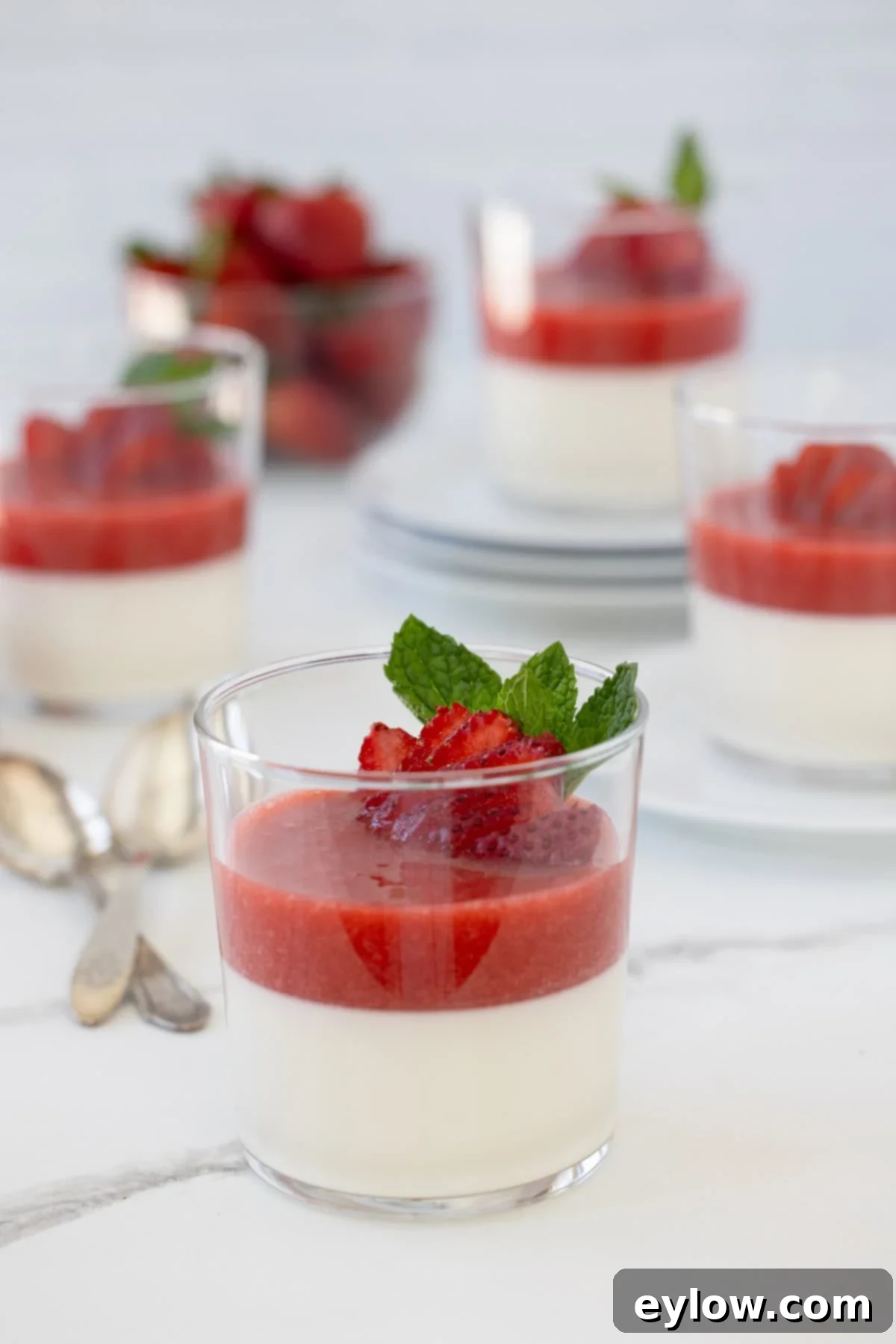
Unlike the traditional Italian classic which often involves the slightly challenging process of unmolding (and can lead to presentation mishaps!), this strawberry panna cotta recipe is designed for ease. By serving it in individual glasses, you eliminate any fuss or stress, making it a perfect no-fail option for home cooks. The Italian term “panna cotta” literally translates to “cooked cream,” and this recipe truly embodies that simple, elegant concept. The delightful result is a beautifully creamy, impeccably portioned dessert that looks as sophisticated as it tastes, without the worries of perfect plating. It’s an exquisite choice for holiday gatherings, special occasions, or even just when you crave a refined yet simple sweet indulgence during a busy week.
Why This Strawberry Panna Cotta Recipe Will Be Your New Favorite
This delightful strawberry panna cotta isn’t just a dessert; it’s an experience waiting to happen. Here’s why you’ll absolutely love making and serving this recipe:
- Effortlessly Easy to Make: Forget complicated techniques and endless ingredient lists. This recipe calls for just a few staple ingredients and a straightforward method. Even novice cooks can achieve professional-level results, making it an accessible option for anyone looking to create a stunning dessert.
- Flexible Sweetener Options: Whether you prefer the classic sweetness of sugar or are looking for healthier alternatives, this recipe adapts beautifully. You can use traditional granulated sugar, fine caster sugar, or easily opt for sugar-free sweeteners like allulose or monk fruit blends without compromising on taste or texture.
- Elegant Individual Servings: Presenting desserts in individual glasses elevates the dining experience. Not only does it offer an elegant and sophisticated presentation perfect for entertaining, but it also ensures perfectly portioned servings, making it easier to manage and enjoy.
- Perfect Make-Ahead Dessert: One of the biggest advantages of panna cotta is its ability to be prepared in advance. This saves you valuable time on the day of your event, allowing you to focus on other aspects of entertaining or simply relax. Just chill, top with sauce, and serve!
- Versatile Flavor Pairing: While fresh strawberry sauce is a natural companion, the vanilla panna cotta base is incredibly versatile. It pairs wonderfully with a wide array of fruit toppings, from a tangy blueberry compote (made with frozen blueberries for convenience) to exotic mango or pineapple.
Essential Ingredients for Your Perfect Panna Cotta
Crafting this luscious strawberry panna cotta requires a handful of high-quality ingredients, each playing a crucial role in achieving its signature creamy texture and delightful flavor. Here’s what you’ll need:

- Heavy Cream: This is the star of panna cotta, providing its characteristic rich and luxurious mouthfeel. Opt for heavy whipping cream with a fat content of 35% to 40%. While 35% is standard, some dairies offer higher fat varieties which can result in an even creamier, more indulgent dessert. The higher fat content contributes significantly to the silky texture.
- Milk: Whole milk is recommended for its richness, which complements the heavy cream beautifully without making the panna cotta overly dense. It helps achieve the perfect balance in consistency and flavor.
- Gelatin: The setting agent that gives panna cotta its jiggle and holds its shape. While you can use standard gelatin powder, I highly recommend using leaf gelatin (also known as sheet gelatin) for superior results. Leaf gelatin dissolves more evenly and creates a clearer, smoother texture. (See detailed notes below on leaf vs. powdered gelatin).
- Strawberries: The key to the vibrant, fresh sauce. You can use either fresh strawberries when they are in season for the best flavor, or frozen strawberries for year-round convenience. If using frozen, thaw them first.
- Sweetener: Your choice here can be granulated sugar, superfine sugar (also known as caster sugar, which dissolves more quickly), or a sugar-free alternative. For sugar-free options, pure allulose powder or a granular monk fruit-allulose blend are excellent choices that provide sweetness without the carbs. Avoid erythritol, as it can sometimes leave a cooling aftertaste.
- Vanilla: Essential for imparting that classic, warm, and comforting flavor. A good quality vanilla extract or a rich vanilla paste will make a noticeable difference. Vanilla paste is often preferred by chefs for its concentrated flavor and visible vanilla bean flecks, offering an easier alternative to scraping vanilla pods. Consider good vanilla extract or the vanilla paste for ease.
For precise measurements of all ingredients, including a pinch of salt to enhance the flavors, please refer to the detailed recipe card at the bottom of this post.
Creative Substitutions & Flavorful Variations
This strawberry panna cotta recipe is wonderfully flexible, allowing for various substitutions and creative variations to suit your taste, dietary needs, or seasonal availability. Don’t hesitate to experiment and make it your own!
- Flavor Swap: While vanilla is classic, you can easily alter the panna cotta’s base flavor. Substitute the vanilla extract with almond extract for a delicate nutty note, or a touch of orange or lemon zest for a bright, citrusy twist. A hint of cardamom or cinnamon can also add a unique warmth.
- Sugar-Free Option: For a delicious sugar-free version, replace traditional sugar with pure allulose powder or a granular monk fruit-allulose blend. Allulose is a fantastic choice as it behaves very similarly to sugar in terms of texture and taste, without the glycemic impact. Be sure to skip erythritol, which can sometimes crystalize or leave an unpleasant aftertaste. Refer to the notes in the recipe card for precise measurements for sugar substitutes.
- Berry Swap: The beauty of this recipe lies in its versatility with fruit toppings. Instead of strawberries, try creating a sauce or compote using other seasonal berries like plump blueberries, tart raspberries, or sweet blackberries. A mix of berries can also create a stunning visual and flavor profile.
- Alternative Setting Agent: If you prefer a plant-based option or have dietary restrictions, agar-agar can be used as a substitute for gelatin. Agar-agar is derived from seaweed and creates a firmer, more brittle set than gelatin, so adjust quantities carefully according to package instructions for the desired consistency. It’s an excellent vegan alternative for achieving a similar dessert texture.
- Seasonal Toppings: Beyond berries, think seasonally! In the fall, a warm cinnamon apple compote makes a comforting and delicious topping. During the summer, a fresh peach or mango puree would be equally delightful.
Step-by-Step: How to Make Silky Strawberry Panna Cotta
Creating this elegant strawberry panna cotta is surprisingly straightforward. Follow these detailed steps for a perfectly smooth and delicious dessert every time. Remember, the key to success lies in careful measurements and proper chilling.
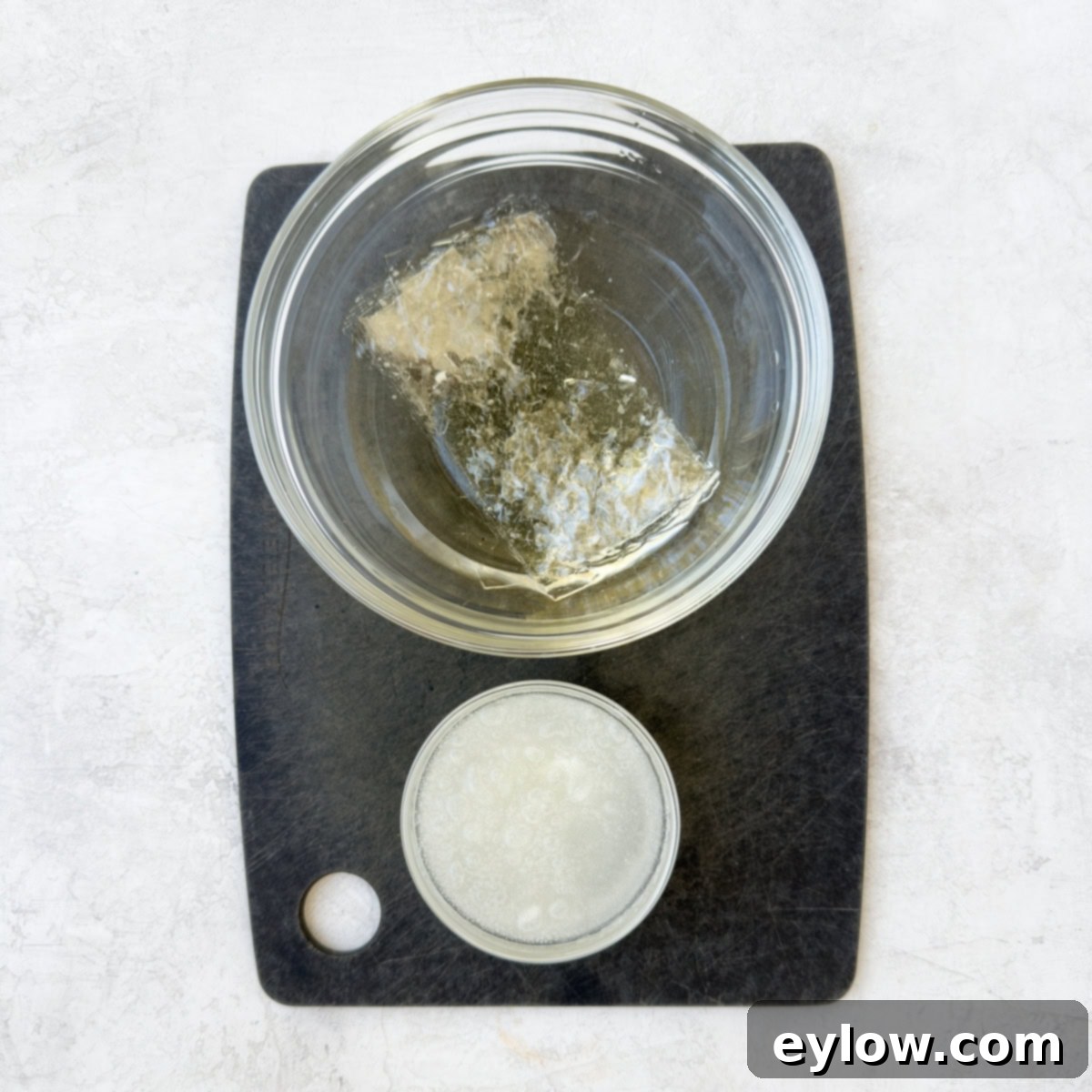
- Bloom the Gelatin: The first crucial step is to properly hydrate your gelatin. If using powdered gelatin, sprinkle it evenly over 2 tablespoons of cold water in a small bowl. For leaf gelatin, submerge the sheets in enough cold water to cover them completely. Allow either type to stand undisturbed for 5-10 minutes. This process, called “blooming,” softens the gelatin and prepares it to dissolve smoothly into the warm cream mixture.
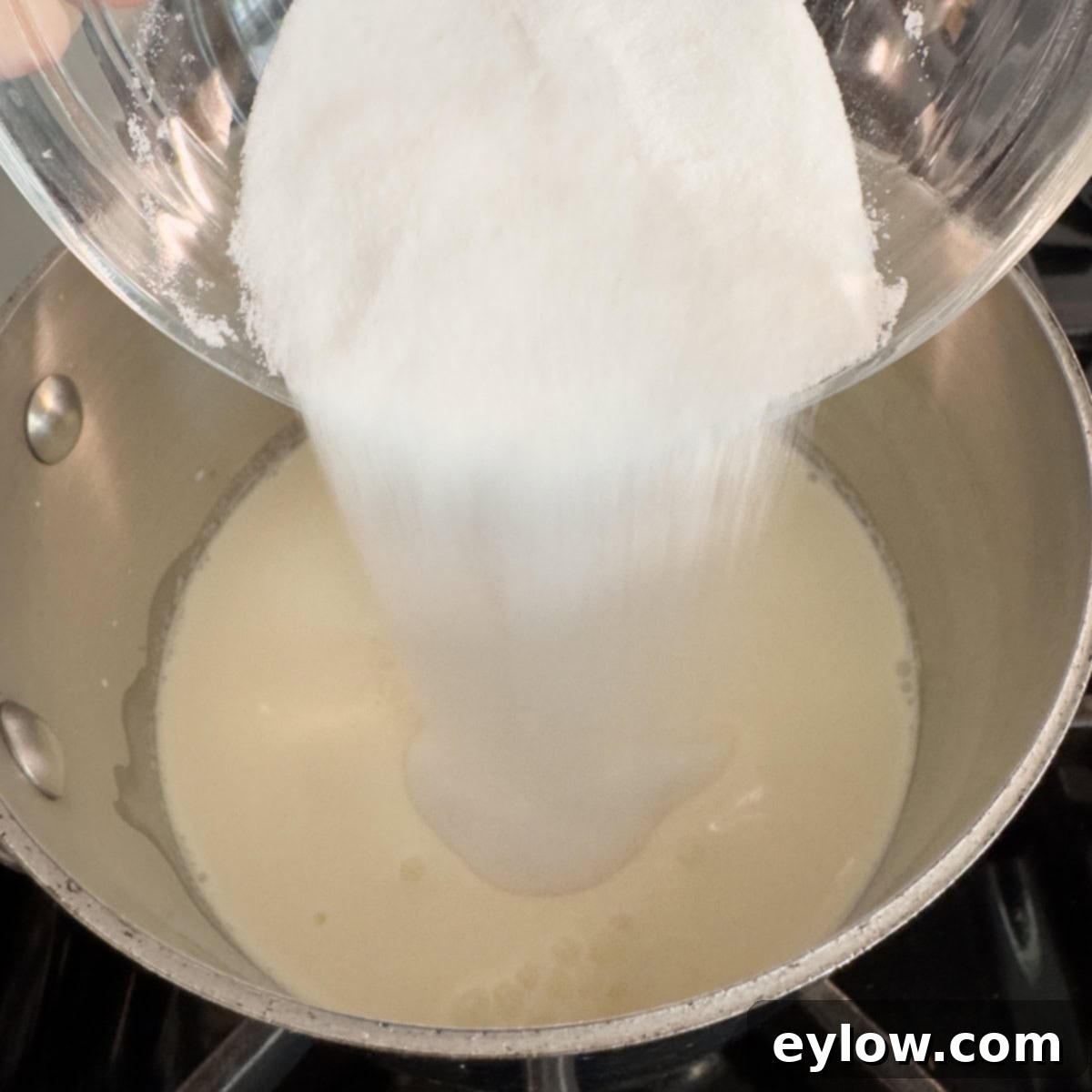
- Heat the Cream Mixture: In a small, heavy-bottomed saucepan (a 2-quart size is ideal), combine the heavy cream, whole milk, and your chosen sweetener (sugar or sugar-free alternative). Stir continuously with a whisk or spoon until the sweetener is completely dissolved. Gently heat the mixture over medium-low heat, bringing it to a strong simmer but being careful not to let it boil. Aim for a temperature between 180°F and 190°F. This usually takes about 5-7 minutes. Heating it slowly prevents scorching and allows the flavors to meld.
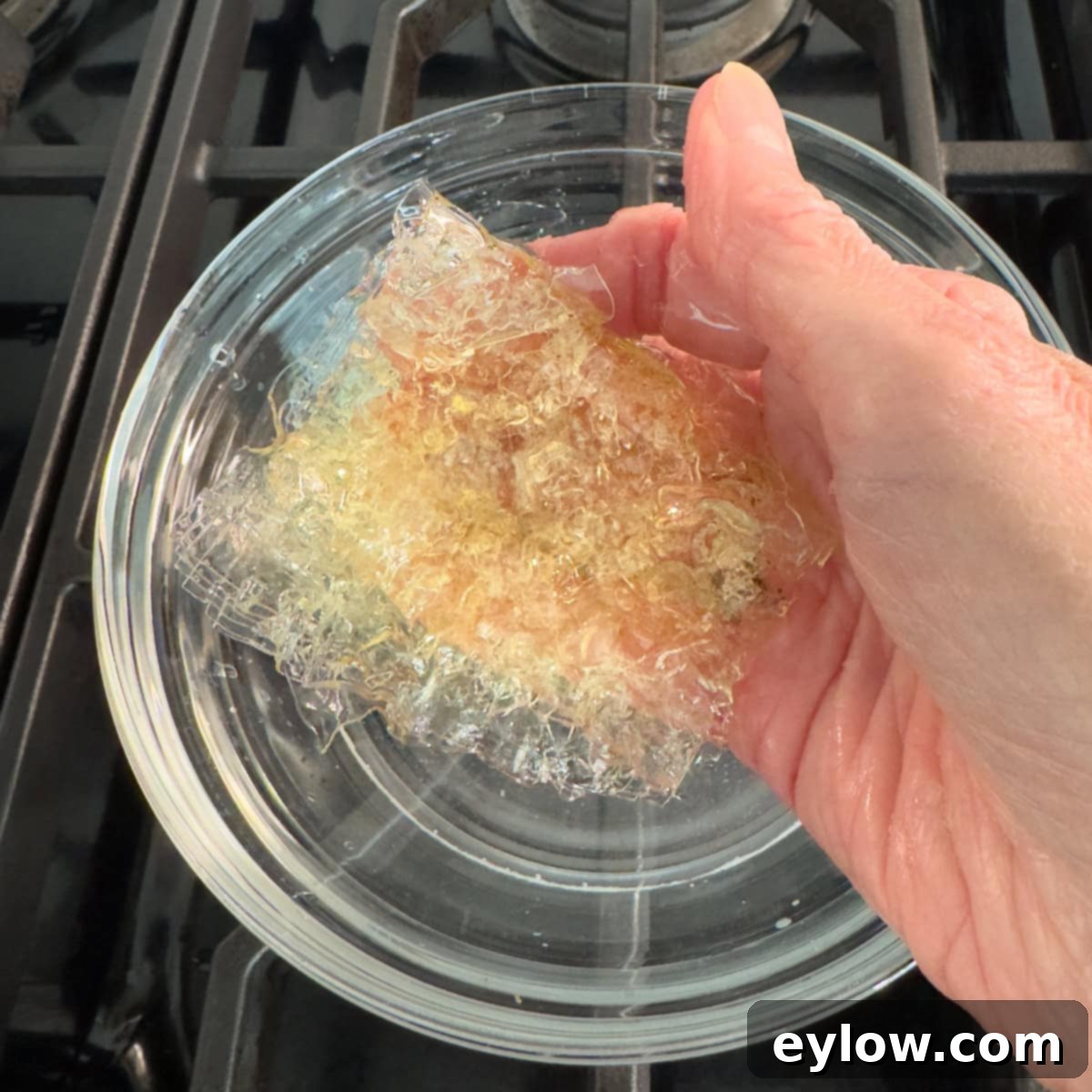
- Incorporate the Gelatin: Once the cream mixture reaches the desired temperature, remove the pan from the heat. For leaf gelatin, gently squeeze out any excess water before adding the softened leaves directly to the hot cream. If using powdered gelatin, simply add the bloomed mixture. Stir immediately and continuously until the gelatin is completely dissolved and smoothly incorporated into the warm liquid. There should be no lumps.

- Add Vanilla: After the gelatin is fully dissolved, stir in the vanilla extract or vanilla paste. This is added after removing from heat to preserve its delicate aroma and flavor, which can diminish if cooked too long. Give it a good stir to ensure even distribution.
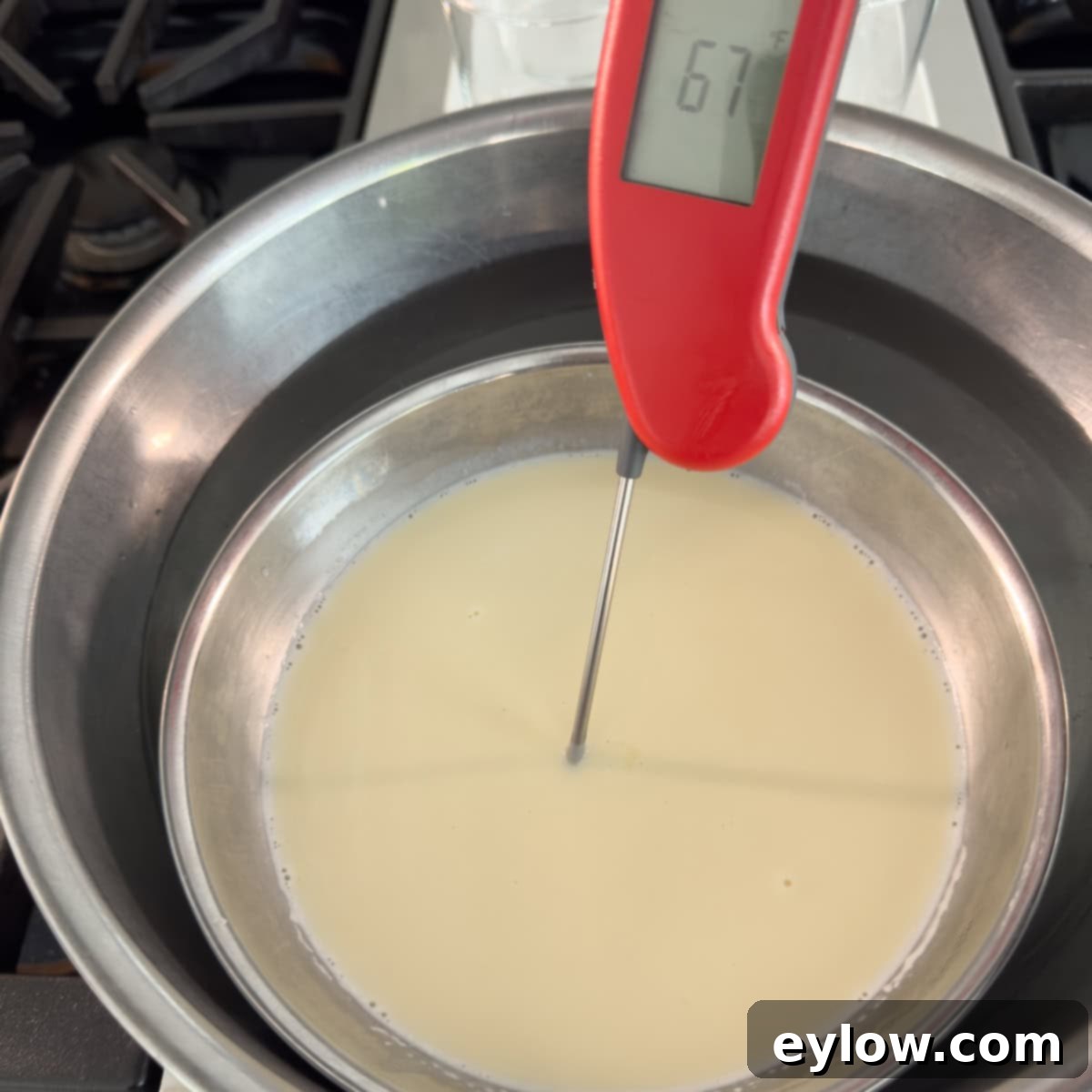
- Cool the Mixture (Ice Bath): To speed up the chilling process and prevent the gelatin from setting prematurely in the pot, carefully pour the panna cotta mixture into a clean medium bowl. Place this bowl into a larger bowl filled with ice and cold water (an ice bath). Stir the panna cotta mixture occasionally until it cools to about 70°F (21°C) or below. This step ensures an even set and a smoother final texture.
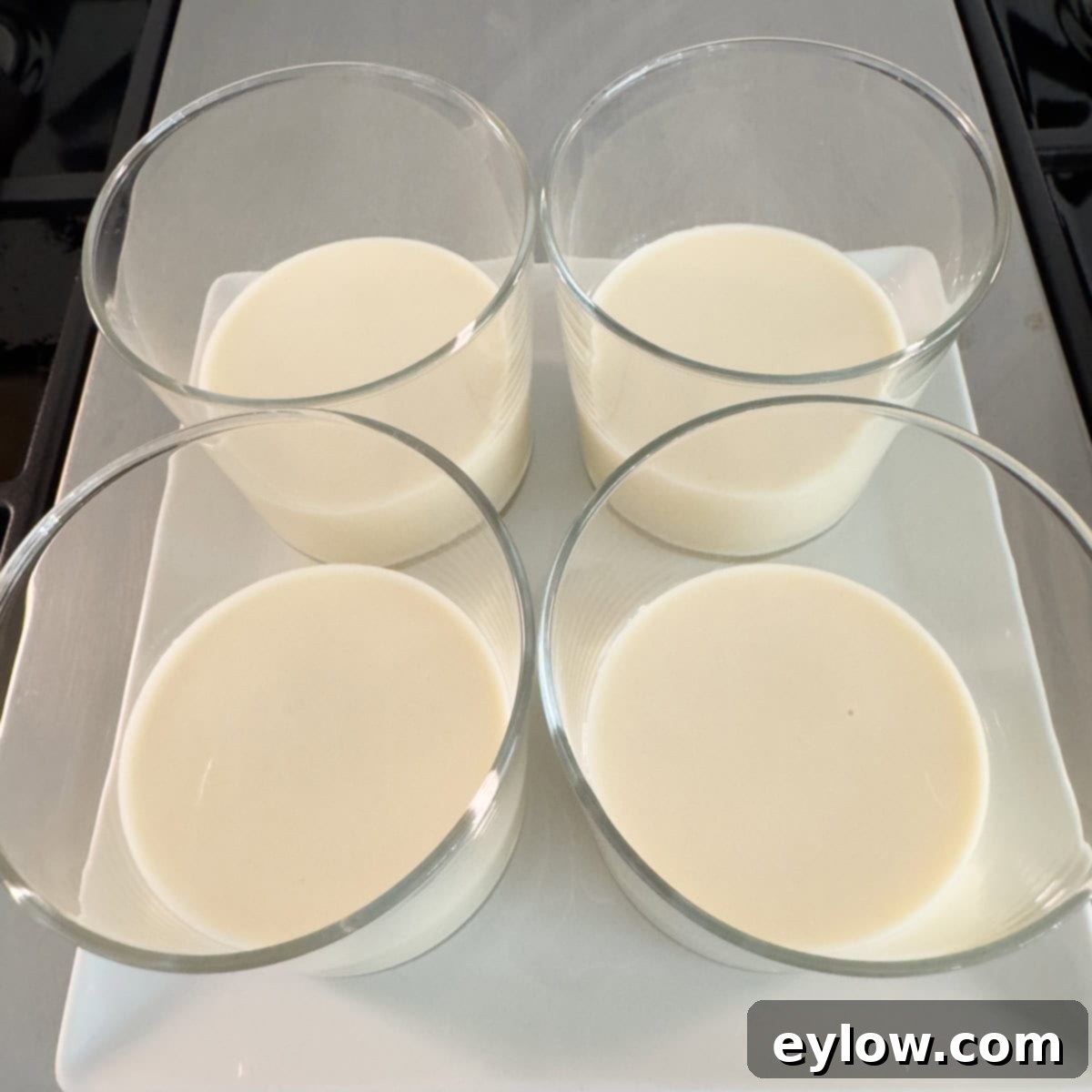
- Portion and Chill: Once the panna cotta mixture has cooled, carefully divide it equally among your chosen serving glasses or ramekins. Gently transfer these vessels to the refrigerator. Chill for at least 4 hours, or preferably overnight, until the panna cotta is completely set and firm. For best results and to prevent odors, cover the glasses loosely with plastic wrap once they are cool to the touch.
Chef’s Tip: Choosing the Right Serving Vessels: The choice of serving vessel greatly influences presentation. While the 10-ounce glasses shown in the images are perfect for generous servings, 8-ounce glasses or classic porcelain ramekins also work beautifully. Consider the occasion when choosing size and shape. Just ensure that your chosen containers are heat-safe, as you’ll be pouring a warm cream mixture into them. For a more sophisticated touch, opt for clear glass to showcase the panna cotta’s creamy color and the vibrant strawberry sauce.
Crafting the Perfect Strawberry Sauce
While your vanilla panna cotta is setting up in the refrigerator (which usually takes about an hour and a half to two hours for a decent set), you can prepare the simple yet sensational strawberry sauce. This sauce adds a burst of fresh fruit flavor and a beautiful visual contrast to the creamy panna cotta.
Begin by selecting four large, perfectly ripe strawberries to reserve for garnish – these will add a lovely fresh touch to your finished dessert. Use the remaining strawberries (approximately 11-12 ounces or about 300-340 grams) to create the luscious sauce.
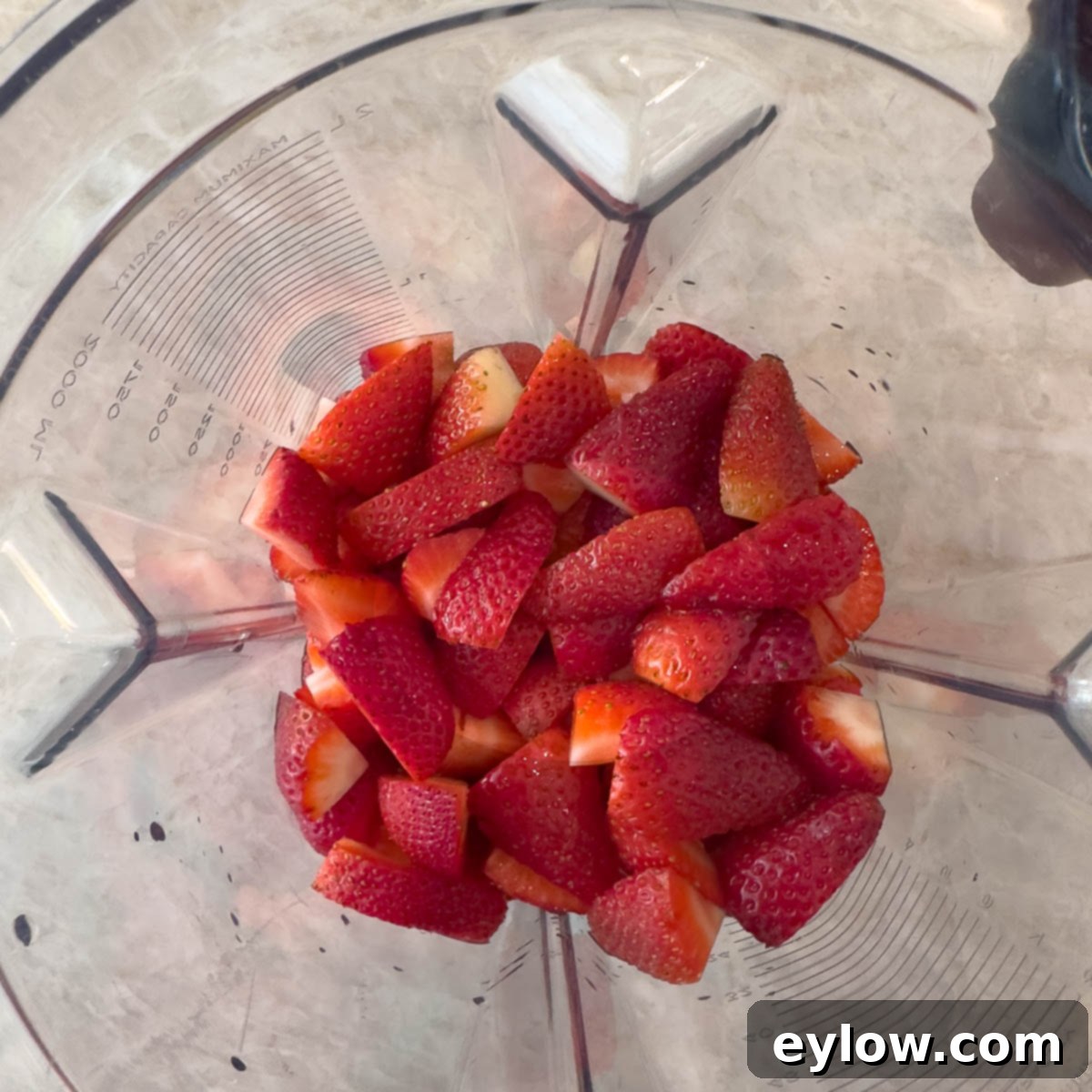
- Prepare and Puree Berries: Thoroughly wash and hull your strawberries, then chop them into smaller pieces. Transfer the chopped berries to a blender or food processor. For an enhanced flavor, add 1-2 teaspoons of fresh lemon juice (this is optional but highly recommended as it brightens the fruit’s taste). If your strawberries aren’t very sweet, or if you prefer a sweeter sauce, add a little sugar or allulose powder to taste. Blend until the mixture is completely smooth and uniform.
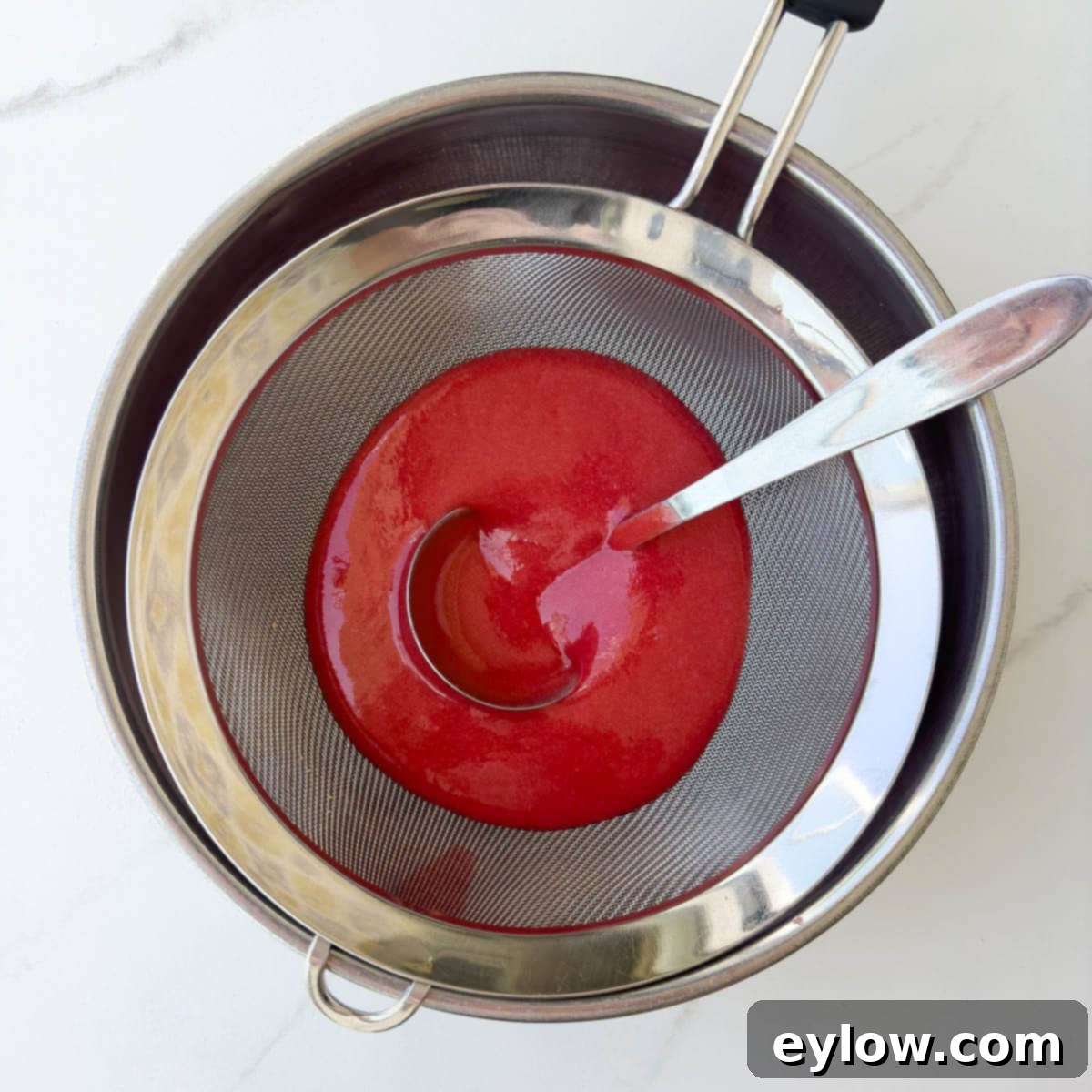
- Strain for Silky Smoothness: For a truly elegant, restaurant-quality sauce, pour the pureed strawberries through a fine-mesh sieve set over a bowl. Using the back of a ladle or a flexible spatula, gently press the puree through the sieve to remove all the tiny seeds and any fibrous bits. This step results in an incredibly smooth, luxurious strawberry sauce that coats the back of a spoon beautifully.
Once your strawberry sauce is prepared, cover it tightly and refrigerate until it’s time to serve your panna cotta. This sauce can also be made a day or two in advance. For more detailed tips and a comprehensive guide on making berry sauces, you can refer to my full Strawberry Coulis recipe.
Chef’s tip: This vanilla panna cotta base is incredibly versatile, making it a perfect foundation for whatever fruit is best seasonally. Don’t limit yourself to strawberries! Explore delightful toppings like sweet raspberries, juicy blackberries, tangy blueberries, tropical pineapple, or succulent mango. You can even combine different fruits for a vibrant medley. This single dessert recipe can gracefully adapt to many occasions, from an elegant dinner party to a casual backyard get-together, making it an indispensable addition to your recipe file.
Understanding Gelatin: Leaf vs. Powdered
Gelatin is the unsung hero of many delicate desserts, including panna cotta, providing that characteristic wobble and smooth set. Both leaf gelatin (also known as sheet gelatin) and powdered gelatin serve the same essential purpose – gelling and setting – but they differ significantly in their form, ease of use, and the final texture they impart.
Leaf Gelatin (Sheet Gelatin) comes in thin, translucent, flexible sheets. It’s often favored by professional chefs for its precise and consistent gelling power. One of its main advantages is that it dissolves more evenly and cleanly, leading to a crystal-clear, smoother, and more refined texture in the final product. This results in a panna cotta that truly melts in your mouth without any hint of grittiness.
To use leaf gelatin, you first soften it by soaking it in cold water (a process known as “blooming”). Once softened, you gently squeeze out any excess water – this is critical to ensure the right consistency and avoid diluting your dessert – then add the bloomed gelatin directly to a warm liquid (like the cream mixture) to melt. Leaf gelatin comes in various strengths, known as “bloom,” with silver or 170 bloom being a versatile medium strength that I highly recommend for panna cotta. I personally use a versatile medium strength called 170 bloom.
Powdered Gelatin, on the other hand, is granulated and more widely available in most grocery stores. It’s often seen as easier to measure, usually by the teaspoon or tablespoon. Like leaf gelatin, powdered gelatin must also be bloomed in cold water before use. You sprinkle the powder over cold water and let it sit for about 5 minutes to absorb the liquid and swell before adding it to a warm mixture. Both types of gelatin will successfully set panna cotta, but leaf gelatin generally offers a more superior, consistent, and delicate result.
For conversion purposes, a general rule of thumb is that one sheet of medium-strength leaf gelatin is equivalent to approximately ½ teaspoon of powdered gelatin. Always check the specific package instructions for precise conversions, as bloom strength can vary between brands.
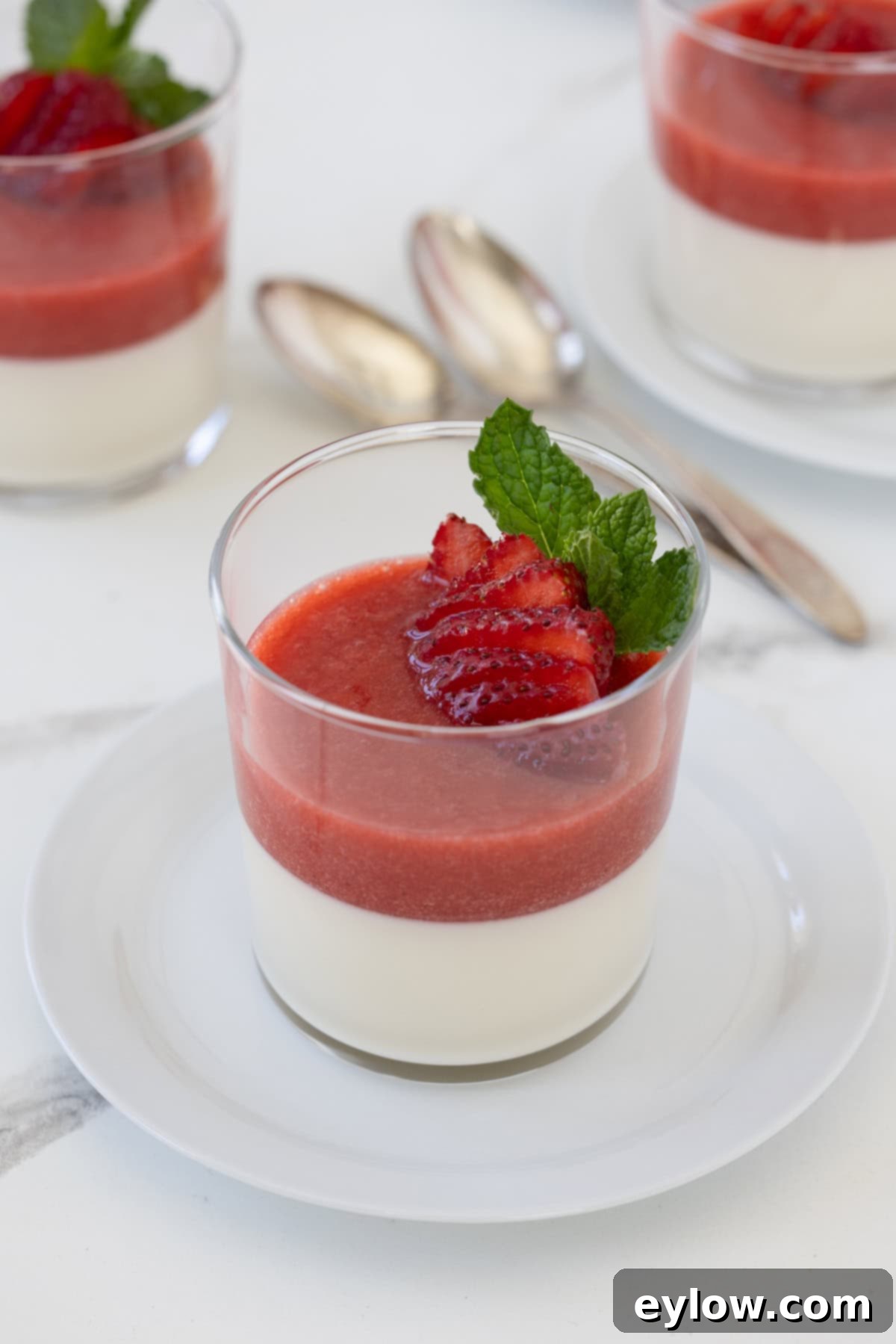
Elegant Serving Suggestions
Once your beautiful strawberry panna cotta is perfectly set and chilled, the final touches of serving can transform it into a truly memorable dessert. Here are some elegant suggestions to enhance its appeal:
- Classic Strawberry Topping: When you’re ready to serve, carefully divide the prepared strawberry sauce among the four glasses, pouring it gently over the set panna cotta. For a final flourish, top each with a slice or two of the fresh strawberries you reserved earlier. A small, vibrant mint leaf adds a beautiful pop of color and a refreshing aroma.
- Chocolate Shavings: For an extra touch of indulgence, use a microplane zester to shave dark chocolate or white chocolate curls directly over the top of the strawberry sauce and fresh berries. The chocolate provides a lovely textural contrast and a sophisticated flavor pairing.
- Mixed Berry Delight: Instead of just strawberries, consider using a mix of fresh berries like raspberries, blueberries, and blackberries for garnish. Their varying colors and slightly different flavor profiles will add complexity and visual appeal to your dessert.
- Lemon Curd Layer: For those who love a zesty twist, add a delicate layer of my easy sugar-free lemon curd to the panna cotta. You can spoon the lemon curd directly onto the set panna cotta before adding the strawberry sauce, or even replace the strawberry sauce entirely with lemon curd for a bright and tangy lemon panna cotta. The combination of creamy vanilla and tart lemon is simply divine.
- Crunchy Elements: A sprinkle of finely chopped pistachios or toasted almonds can add a delightful crunch, providing a textural contrast to the smooth panna cotta.
Storing and Freezing Your Panna Cotta
One of the many benefits of panna cotta is its make-ahead potential, making it a perfect dessert for entertaining. However, proper storage is key to maintaining its exquisite texture and flavor.
Storing in the Refrigerator: Your delicious strawberry panna cotta can be prepared and stored in the refrigerator for up to 4 days. To keep it fresh and prevent it from absorbing any refrigerator odors, ensure each individual serving glass or ramekin is tightly covered with plastic film. It’s best to add the strawberry sauce and any garnishes just before serving to maintain their freshness and appearance.
Freezing Recommendations: While some sources suggest freezing panna cotta for up to a month, I generally do not recommend it. Freezing can significantly alter the delicate, silky-smooth texture that makes panna cotta so special. The dairy fats and gelatin can separate or become grainy upon thawing, resulting in a less pleasant mouthfeel. Since this recipe is incredibly simple and quick to prepare, I always advocate for making it fresh, even if it means preparing it just a day or two in advance. If you decide to experiment with freezing, ensure the panna cotta is frozen without the sauce, and thaw it very gently in the refrigerator overnight. Freeze the strawberry sauce separately, if desired.
Frequently Asked Questions About Panna Cotta
Here are answers to some common questions you might have when making this delightful strawberry panna cotta:
For optimal results and a firm, stable set, allow your panna cotta to chill in the refrigerator for at least a few hours, ideally 4 hours, or even overnight. While it might appear set sooner, a longer chilling time ensures a perfectly firm yet wobbly consistency. I often find mine is sufficiently set after about 1 hour and 15 minutes, but giving it more time truly perfects the texture.
If you choose to use ramekins instead of serving glasses and wish to unmold your panna cotta for a classic presentation, here’s a simple trick: briefly dip the bottom of the ramekin into very hot water for about 3 seconds. Then, run a thin-bladed knife carefully around the inside edge of the ramekin to gently loosen the panna cotta. Place a small dessert plate on top of the ramekin and invert it. The panna cotta should slide out cleanly onto the plate. Be gentle to maintain its shape.
Absolutely! One of the most fantastic aspects of panna cotta is its suitability for advance preparation. You can comfortably make this dessert 3-4 days ahead of your planned serving time. Simply keep the individual servings tightly covered with plastic film in the refrigerator. When it’s time to serve, just add your desired sauce and garnishes for a fresh and elegant presentation.
Several factors can prevent panna cotta from setting. The most common reasons include not blooming the gelatin correctly (either too little water for powdered gelatin or not squeezing enough water from leaf gelatin), boiling the cream mixture (which can degrade gelatin’s setting power), or not allowing enough chilling time. Ensure your gelatin is fully dissolved in the warm cream and that your panna cotta chills for at least 4 hours.
While this recipe calls for dairy cream and whole milk for optimal richness and texture, you can experiment with milk alternatives. Full-fat coconut milk can create a wonderfully rich and slightly tropical-flavored panna cotta. Other alternatives like almond milk or soy milk might yield a less creamy texture due to lower fat content, but can still work if adjusted with additional gelatin for firmness. Always opt for unsweetened versions if replacing milk.
Discover More Strawberry Delights!
If your love for strawberries knows no bounds, you’re in for a treat! Explore more of my favorite recipes that showcase this sweet, juicy, and incredibly versatile berry. From hearty breakfast muffins and refreshing salads to flavorful sauces and invigorating smoothies, there’s a strawberry-centric dish here for every craving and occasion. Dive into these delightful recipes and let the fresh taste of strawberries brighten your day!
- Gluten Free Strawberry Muffins
- Fast and Fresh Strawberry Coulis
- Strawberry Goat Cheese Salad
- Strawberry Yogurt Smoothie with Banana
Did You Make This Recipe?
If you’ve had the pleasure of making this delightful strawberry panna cotta, I would absolutely love to hear about your experience! Your feedback is invaluable, and I truly enjoy connecting with fellow home cooks. Please take a moment to add your comment below and share your thoughts. If you loved it, kindly consider giving it a 5-star rating! Your ratings and reviews are incredibly helpful to other readers who are looking for their next favorite dessert.
📖 Recipe
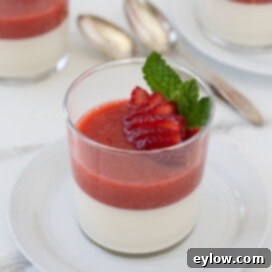
Strawberry Panna Cotta
Sally Cameron
Pin Recipe
Equipment
-
Small pot 2-3 quarts
-
Digital thermometer
Ingredients
Panna cotta
- 2-3 sheets 170 leaf gelatin or 2 teaspoons powdered gelatin
- 1 ½ cups heavy whipping cream 36%-40%
-
½ cup whole milk
- 2 teaspoons vanilla extract or 1 teaspoon vanilla paste
- ½ cup sugar notes below for sugar-free version
Strawberry sauce
- 1 pound fresh strawberries
- 1-2 tablespoons sugar or monk fruit or more to taste, or if needed
- 1 pinch sea salt
Instructions
For powdered gelatin
-
Add the gelatin powder to a small bowl with 2 tablespoons of water and allow it to soften for 5 minutes, then it is ready to use.
For leaf gelatin
-
Break or (cut with scissors ) the leaf gelatin sheets in smaller pieces so they and add them to a small bowl. Cover with cold water and allow to soak for 5 minutes until soft and hydrated. Squeeze out excess water and gelatin is ready to use. Discard water. Use 2 leaves for softer panna cotta or 3 for firmer texture.
Heat the dairy
-
First, set up an ice bath. Fill a large bowl ½ full with ice and cold water.
-
Add the heavy cream and milk to a 3 quart pan, stir in your sweetener until smooth. Bring it up to a strong simmer, but not a boil. Remove the pan from the heat, add the squeezed out gelatin, and stir until smooth and the gelatin has melted in. Lastly add the vanilla and a pinch of salt.
-
Pour the cream mixture into a medium bowl and carefully place it in the ice bath. Chill until 70°F or lower, 15-20 minutes. When cold, divide the panna cotta it between 4 ramekins or glasses and move them to the refrigerator to set up, about 4 hours. Cover with plastic film.
Make the strawberry sauce (or make it ahead and refrigerate)
-
While the panna cotta is chilling, make the sauce. With a paring knife slice the top off of the strawberries. Save 4 nice berries for garnish if desired.
-
Quarter the strawberries and puree in a food processor or blender. Pour the strawberry puree through a fine sieve into a large measuring cup. Push the puree through with a flexible or a small ladle (faster).
Add 1-2 tablespoons of sugar or a little more allulose powder depending on the sweetness of the berries and your sweetness preference. Cover sauce and refrigerate until serving.
To serve
-
When panna cotta is set, top it with tablespoons of the strawberry sauce nd garnish with a fresh strawberry if desired.
Panna cotta lasts up to 4 days in the refrigerator, covered. Do not freeze, it ruins the texture.
Notes
For sugar-free version: Replace the sugar with ⅔-3/4 cup of powdered allulose for similar sweetness. Allulose is 70% as sweet as sugar so it takes more. Granular monk fruit/allulose blend also work beautifully, and no sifting required. It is as sweet as sugar so can be used 1:1 and works great.
For the sauce, use 1½ tablespoons of powdered allulose in place of 1 tablespoon of sugar. Be sure to sift it before adding it to the cream mix so there are no lumps.
Because powdered allulose is not metabolized by our bodies, remove 72 carbs from the overall nutrition calculation, or 18 carbs per serving! And it tastes great!
Tips for using leaf gelatin (which is what I prefer)
You need 2-3 gelatin leaves of silver level (170 bloom); 2 leaves for a softer panna cotta or 3 leaves for a firm panna cotta.
I use Perfectagel leaf gelatin. Buy it on Amazon, Walmart online, or other kitchen and cooking supply resources.
Don’t leave the leaf gelatin to soak in the water too long as this will diminish its setting properties. 5-10 minutes is all you need, then squeeze out the water and use.
When adding any gelatin to a liquid make sure that it is not boiling as this weakens the setting capability of the protein.
Panna Cotta Nutritionals Alone – 331 kcals, 4 carbs (if made with the monk fruit, no sugar), 4 protein, 33 fat. No topping or sauce.
